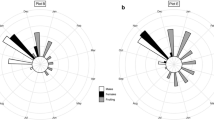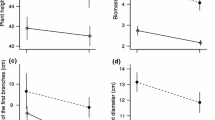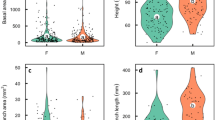Summary
Desert populations of the evergreen dioecious shrub Simmondsia chinensis exhibit sex-related leaf and canopy dimorphisms not present in populations from more mesic coastal environments. Leaves on female shrubs have characteristically larger sizes, greater specific weights, and greater water-holding capacity than male leaves in desert habitats. In coastal scrub environments no significant difference is present, with leaf characteristics of both sexes similar to those of desert male shrubs. Desert female shrub canopies are typically relatively open with little mutual branch shading. In male shrubs canopies are more densely branched with considerable mutual shading of branches. Female plants allocate a greater proportion of their vegetative resources to leaves than do male plants. Considering total biomass, male plants allocate 10–15% of their resources (biomass, calories, glucose-equivalents, nitrogen, phosphorus) to reproductive tissues. Female allocation is dependent on seed set. At 100% seed set females would allocate 30–40% of their resources to reproduction, while female reproductive investment would equal that of males at approximately 30% seed set. Sexual dimorphism and the associated physiological characteristics in Simmondsia act as an alternative to differential habitat selection by male and female plants. Female plants respond to limited water resources in desert areas by increasing their efficiency in allocating limited resources to reproductive structures.
Similar content being viewed by others
References
Adams, J.A., Bingham, F.T., Kaufmann, M.R., Hoffman, G.J., Yermanos, D.M.: Responses of stomata and water, osmotic and turgor potentials of jojoba to water and salt stress. Agronomy J. 70, 381–387 (1978)
Adams, J.A., Johnson, H.B., Bingham, F.T., Yermanos, D.M.: Gaseous exchange of Simmondsia chinensis (jojoba) measured with a double isotope porometer and related to water stress, salt stress, and nitrogen deficiency. Crop. Sci. 17, 11–15 (1977)
Al-Ani, H., Strain, B.R., Mooney, H.A.: The physiological ecology of diverse population of the desert shrub, Simmondsia chinensis. J. Ecol. 60, 41–57 (1972)
Allen, S.E., Germshaw, M., Parkinson, J.A., Quarmby, C.: Chemical Analysis of Ecological Materials. New York, John Wiley (1974)
Collatz, G.J.: Influence of certain environmental factors on photosynthesis and photorespiration in Simmondsia chinensis. Planta 134, 127–132 (1977)
Freeman, D.K., Klickhoff, L.G., Harper, K.T.: Differential resource utilization by the sexes of dioecious plants. Science 193, 597–599 (1976)
Gentry, H.S.: The natural history of jojoba (Simmondsia chinesis) and its cultural aspects. Econ. Bot. 12, 261–295 (1958)
Gentry, H.S.: Supplement to the natural history of jojoba. In: Jojoba and its uses; an International Conference (Haase, E.F., McGinnies, W.G. eds.) pp. 11–12. Tucson, Univ. of Arizona, Office of Arid Lands Studies 1973
Hastings, J.R., Turner, R.M., Warren, D.K.: An atlas of some plant distributions in the Sonoran Desert. Tech. Rep. Meteor. Climat. Arid Regions No. 21. Univ. Arizona Inst. Atm. Physics (1972)
Lloyd, D.: Sex ratios in sexually dimorphic Umbelliferae. Heredity 31, 239–249 (1973)
Melampy, M.N., Howe, H.F.: Sex ratios in the tropical tree Triparis americana (Polygonaceae). Evolution 31, 867–872 (1977)
Opler, P.A., Bawa, K.S.: Sex ratios in tropical forest trees. Evolution 32, 812–821 (1978)
Penning de Vries, F.W.T., Brunsting, A.H.M., Van Laar, H.H.: Products, requirements and efficiency of biosynthesis: a quantitative approach. J. Theor. Biol. 45, 339–377 (1974)
Putwain, P.D., Harper, J.L.: Studies in the dynamics of plant populations V. Mechanisms governing the sex ratio in Rumex acetosa and Rumex acetosella. J. Ecol. 60:113–129 (1972
Sherbrooke, W.C., Haase, E.F.: Jojoba: a way producing shrub of the Sonoran desert. Arid Lands Res. Inform. Paper 5, 1–132. Office of Arid Land Studies, Univ. of Arizona, Tucson (1974)
van Soest, P.J., Wine, R.H.: Determination of lignin and cellulose in acid-detergent fiber with permanganate. J. A.O.A.C. 51, 780–785 (1968)
Williams, I.J.M.: A revision of the genus Leucodendron (Proteaceae). Contrib. Bolus Herbarium 3, 1–416 (1972)
Yermanos, D.M.: Agronomic survey of jojoba in California. Econ. Bot. 28, 160–174 (1974)
Author information
Authors and Affiliations
Rights and permissions
About this article
Cite this article
Wallace, C.S., Rundel, P.W. Sexual dimorphism and resource allocation in male and female shrubs of Simmondsia chinensis . Oecologia 44, 34–39 (1979). https://doi.org/10.1007/BF00346394
Received:
Issue Date:
DOI: https://doi.org/10.1007/BF00346394




